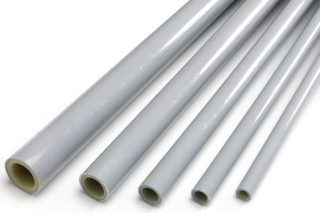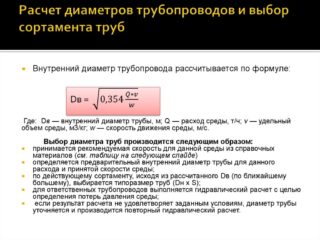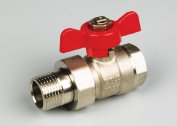The comfortable life of a modern person is impossible without running water. The correct choice of the diameter of the pipe for water supply in a private house will help to avoid troubles and breakdowns caused by improper operation or insufficient throughput of the water supply and drainage systems.
Criteria for choosing the diameter of the pipe for the water supply in a private house

The pipe section is a criterion for calculating the throughput of a pipeline system. For example, a water pipe with a diameter of 32 mm is able to pass 50 liters per minute, and with a cross section of 25 mm - only 30 liters. It is also worth considering the fact that the mixer cannot provide a throughput of more than 5 l / min.
It is recommended that you select the appropriate cross-sectional size of the pipe using the following criteria:
- total length of the water supply network;
- number of water consumption points;
- fluid temperature;
- number of turns and joints;
- the presence / absence of pressure drops in the pipes;
- planned volume of water consumption;
- material for the manufacture of water supply elements;
- type of water supply: centralized or local.
The first two criteria have a direct proportional effect on the diameter. With an increase in the total length of the pipeline and the number of water consumption points, the cross-section of the pipeline should also be taken large. The main points of water consumption include a heating tank, toilet bowl, sink, sink, shower or shower, bathtub, washing machine and / or dishwasher, etc.
The third paragraph draws attention to the fact that polymer structures for supplying / discharging cold and hot water differ in wall thickness. The transfer of hot liquid is carried out in thick-walled pipes. Metal structures can be used with the same thickness.
When creating a system with frequent joints and turns, as well as with uneven water pressure due to the multi-storey building and indirect movement of water, it is necessary to use pipes of increased internal size. You should also choose elements of a larger cross section if a large number of people live or stay in the house.
The selected material determines the future value of the entire system and the degree of complexity of its assembly. The methods used in the technical literature for calculating the throughput of pipes are usually suitable only for metal products (usually steel). Their peculiarity is that during operation the internal diameter gradually changes. This is due to the accumulation of calcareous deposits on the walls and other deposits in one or more layers. Pipes made of polymer materials (plastic, polyethylene, metal-plastic, PVC) do a good job of this. However, they can expand under the influence of hot temperatures. This leads to a drop in pressure, noise and malfunction. Copper elements last longer than steel and polymer, but have a much higher cost.
When connecting to a centralized water main, it is necessary to make a selection of the pipe section only for their wiring around the house. If it is an autonomous option, the costs of well construction or well drilling are additionally taken into account. In the future, the money spent is compensated by independence from external factors and the absence of a constant payment for water supply and sewage.
Pipe diameters
 The main dimensions of water pipes made of steel are given in GOST 3262-75. The diameter of all products manufactured in the world is in the range of 2.5-4000 mm. There are about 50 pipe rental options.GOST established such parameters of pipes as the outer diameter, mass, wall thickness. The common designation is the diameter of the pipe in millimeters and the thread on it in inches. The parameters of the polymer elements of circular cross section (32 sizes in the range of 10-1600 mm) are prescribed in GOST 18599-2001. Products are further divided into four groups according to wall thickness from 2 to 70 mm.
The main dimensions of water pipes made of steel are given in GOST 3262-75. The diameter of all products manufactured in the world is in the range of 2.5-4000 mm. There are about 50 pipe rental options.GOST established such parameters of pipes as the outer diameter, mass, wall thickness. The common designation is the diameter of the pipe in millimeters and the thread on it in inches. The parameters of the polymer elements of circular cross section (32 sizes in the range of 10-1600 mm) are prescribed in GOST 18599-2001. Products are further divided into four groups according to wall thickness from 2 to 70 mm.
The outer diameter is indicated in Latin letters. D or D, inner - in letters d or Dvnand wall thickness - lowercase or uppercase s. The standard does not specify an inner diameter. It can be calculated by subtracting the doubled wall thickness from the external size.
There is also a notation Du (DN Dn), which is used when specifying the conditional diameter (passage) of the rental. In the reference literature there is another name for this concept - "nominal pipe diameter." This is the average size of the pipe rental product (by clearance), which usually differs from that indicated on the marking. It is obtained by rounding the measured inner diameter to the nearest standard value. For example, for pipes with external and internal sections of 156/144 mm and 156/148 mm DN = 150 mm.
Steel products are marked in inches, and copper, aluminum and polymer in millimeters. To correlate these sizes with a combined pipeline system, special tables or programs (applications) are used.
Correspondence of inches to the diameter of the nominal bore of the pipe: ¼ inches - 8 mm; ½ inch - 15 mm; ¾ inch - 20 mm; 1 inch - 25 mm; 1¼ inch - 32 mm; 1½ inches - 40 mm; 2 inches - 50 mm; 2.5 inches - 65 mm.
How to calculate the cross section of water pipes
 To determine which pipe diameter is best used for the water supply of a private house, you need to calculate the approximate length of the created pipeline network. If you want to breed pipes of a standard centralized water supply system, take an average water flow rate of 20 m / s. For this speed, there are the following recommendations for selecting the diameter of the rolling element:
To determine which pipe diameter is best used for the water supply of a private house, you need to calculate the approximate length of the created pipeline network. If you want to breed pipes of a standard centralized water supply system, take an average water flow rate of 20 m / s. For this speed, there are the following recommendations for selecting the diameter of the rolling element:
- The network length is less than 10 meters, the required pipe diameter is 20 mm.
- For pipes with a total length of 10-30 meters, the cross-section of the water supply is taken equal to 25 mm.
- With a network longer than 30 meters, it is recommended to use pipes with a diameter of 32 mm.
The length of one pipe varies from 4 to 15 meters. Pipeline elements must be of high quality and reliable in order to ensure long-term operation of the water supply system without failures.
Throughput - a parameter showing the ratio of the maximum volume of fluid passing through the pipe section per unit time. There are three ways to calculate it:
- According to technical formulas. Averaged indicators apply. The formulas are quite complex and require exact substitution of all data. Therefore, they are practically not applied.
- According to the tables. A fairly simple and accurate solution to the hydraulic problem. Contain dependencies between various parameters. In particular, the dependence of the throughput of the highway on the inner diameter.
- Using special software. According to the source data, the program automatically performs the calculation taking into account all the connected equipment. Substituting the estimated internal diameter, resistance in the elements, roughness index, and the total length of the pipeline, the result is displayed almost instantly.
If the water supply has a length of 30 meters, there are many turns, branches and butt joints, a larger diameter is selected.


